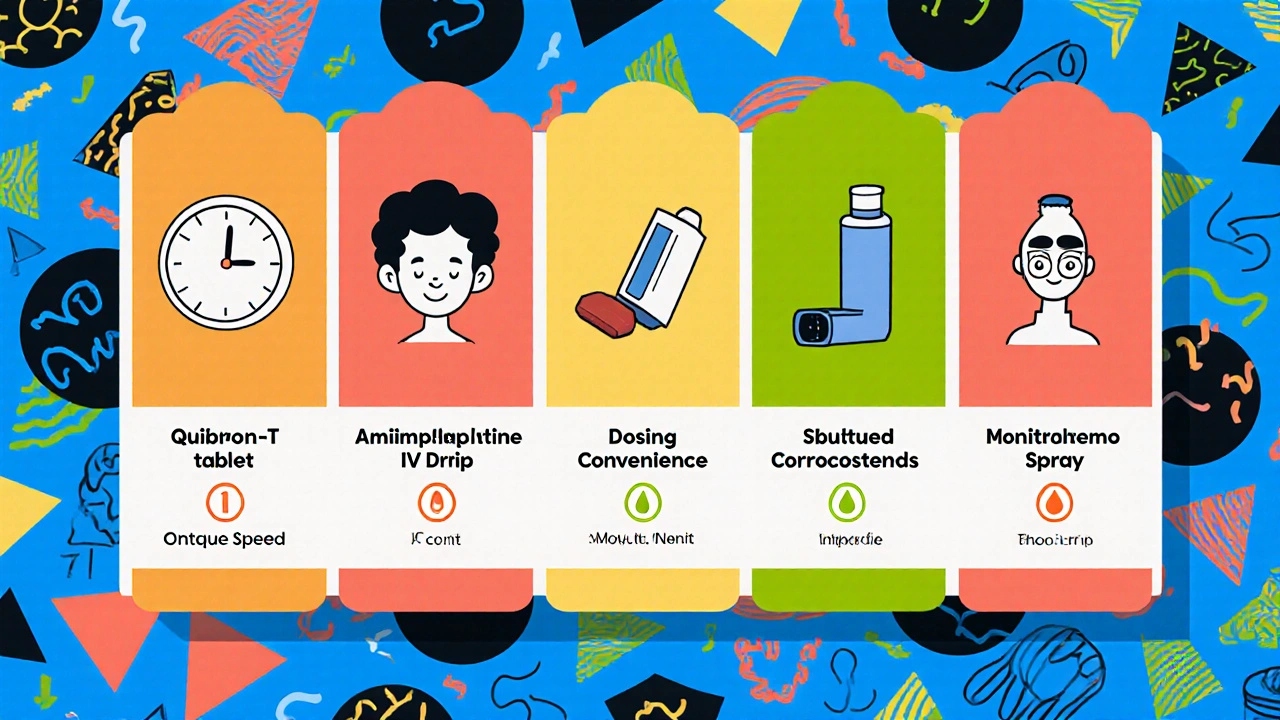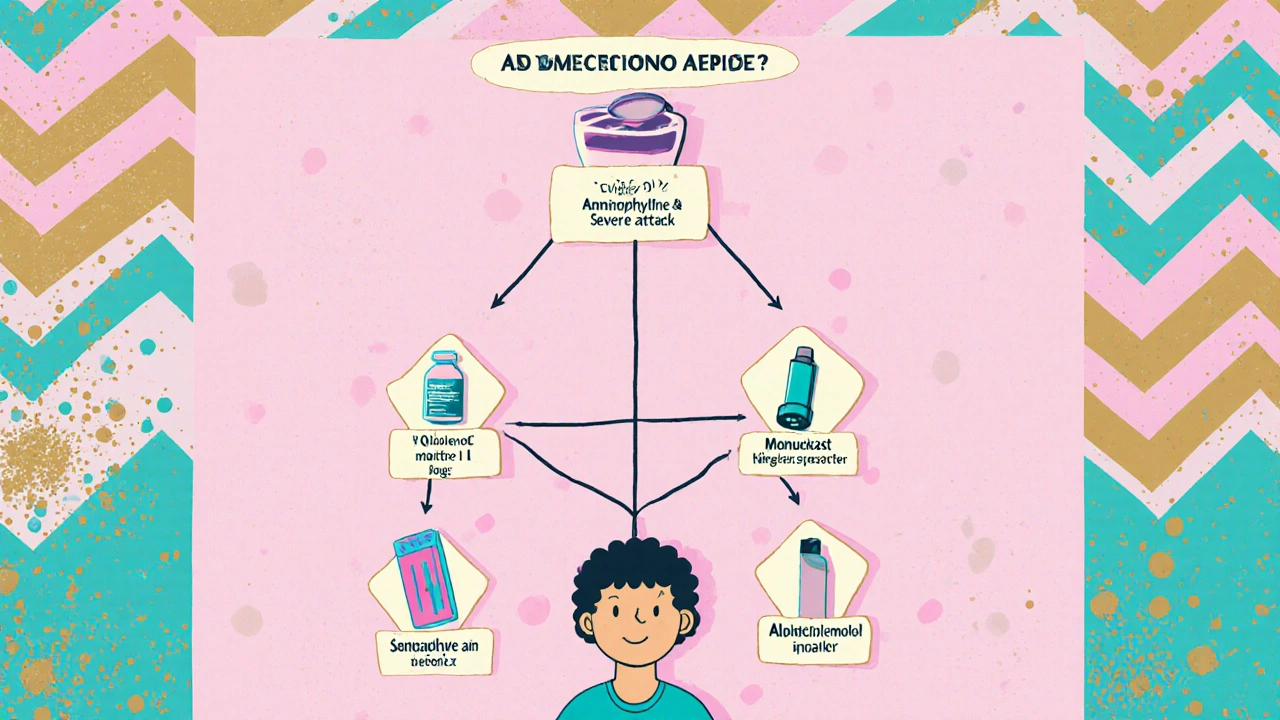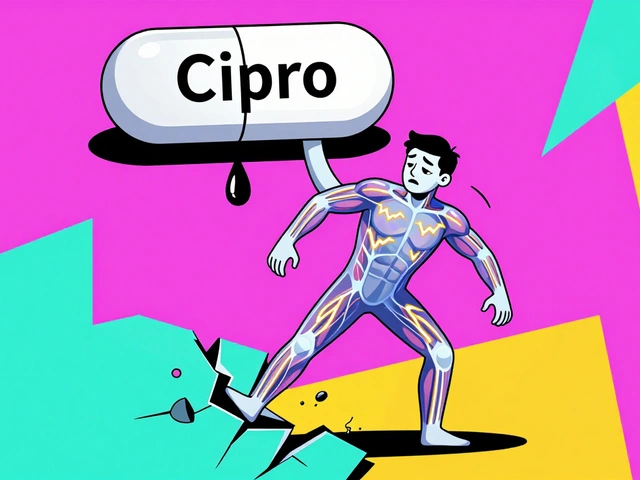Asthma Treatment Decision Tool
Personalize Your Asthma Treatment Choice
This tool helps you determine the most suitable asthma treatment based on your individual priorities. Adjust the sliders to indicate what matters most to you, and we'll recommend the best option for your situation.
When doctors need a bronchodilator that can be taken orally, many think of Quibron‑T. It’s the brand name for a sustained‑release tablet that delivers theophylline, a classic xanthine drug used for asthma and COPD. But the market is crowded: inhaled steroids, leukotriene blockers, short‑acting bronchodilators and even IV formulations compete for the same patients. If you’re trying to decide whether Quibron‑T is right for you, or if another option might fit better, this guide walks through the key factors that matter in real‑world use.
Key Takeaways
- Quibron‑T offers convenient once‑daily dosing but has a narrow therapeutic window, requiring blood‑level monitoring.
- Aminophylline (IV) provides rapid bronchodilation for severe attacks but needs hospital administration.
- Theophylline extended‑release tablets give similar convenience to Quibron‑T with slightly lower monitoring needs.
- Montelukast works well for allergic asthma and has a clean side‑effect profile, though it’s less effective for acute bronchospasm.
- Inhaled corticosteroids remain the most effective long‑term control for persistent asthma, while short‑acting beta‑agonists like salbutamol are best for rescue.
Quibron‑T is a sustained‑release oral tablet that contains the bronchodilator theophylline. It works by relaxing the smooth muscle in the airways and improving the diaphragm’s contractility, which helps patients breathe more easily.
How Quibron‑T Works
Theophylline belongs to the xanthine family, a class of compounds that increase cyclic AMP levels in airway smooth muscle. This biochemical cascade leads to bronchodilation. Quibron‑T’s extended‑release matrix releases theophylline slowly over 12‑14 hours, allowing once‑daily dosing. Because the therapeutic range (10‑20 µg/mL) is narrow, doctors often order periodic serum level checks to avoid toxicity.
Comparison Criteria
To make an apples‑to‑apples assessment, we’ll rank each option on five practical dimensions:
- Efficacy for chronic control: How well it reduces symptoms and exacerbations over weeks to months.
- Speed of relief: How quickly patients feel better during an acute episode.
- Side‑effect profile: Frequency and severity of common adverse events.
- Dosing convenience: Number of daily doses, need for monitoring, and route of administration.
- Cost & accessibility: Approximate out‑of‑pocket price in Australia (2025) and whether a prescription is required.

Side‑by‑Side Comparison Table
| Medication | Efficacy (Chronic) | Onset (Acute) | Common Side‑effects | Dosing / Monitoring | Typical Cost (AU$) |
|---|---|---|---|---|---|
| Quibron‑T (theophylline) | Moderate | 30‑60 min | Nausea, headache, insomnia | 1‑tablet daily; serum level check every 3‑6 months | ~$30 for 30 tablets |
| Aminophylline (IV) | High (severe attacks) | 5‑10 min | Arrhythmia, seizures at high levels | IV infusion; continuous monitoring | ~$150 per 250 mg vial |
| Theophylline ER (generic) | Moderate | 30‑45 min | Similar to Quibron‑T but slightly less nausea | 1‑2 tablets daily; occasional serum check | ~$20 for 30 tablets |
| Montelukast | Good for allergic asthma | 4‑6 h | Mood changes, abdominal pain | 1 tablet nightly; no serum monitoring | ~$40 for 30 tablets |
| Salbutamol (albuterol) | Low for chronic control | 2‑5 min | Tremor, palpitations | Inhaler, 1‑2 puffs as needed; no monitoring | ~$25 for 200‑dose inhaler |
| Inhaled corticosteroids (ICS) | High (long‑term control) | 30‑60 min | Oral thrush, hoarseness | Daily inhaler; no blood monitoring | ~$45 for 120‑dose inhaler |
Deep Dive into Each Alternative
Aminophylline (IV)
Aminophylline is essentially theophylline dissolved in a calcium‑binding solution, allowing it to be given intravenously. It’s reserved for severe asthma or COPD exacerbations that don’t respond to inhaled therapy. Because the drug reaches the bloodstream instantly, doctors can titrate the dose to achieve rapid bronchodilation. The downside is the need for a hospital setting, cardiac monitoring, and a higher risk of toxicity. For most out‑patient scenarios, it’s overkill.
Theophylline Extended‑Release (Generic)
Generic ER tablets contain the same active ingredient as Quibron‑T but often at a lower price point. The release profile is similar, though some brands may have a slightly faster absorption curve. This can translate into a marginally lower need for serum level checks, but the therapeutic window remains narrow. If cost is a concern and you’re comfortable with occasional blood tests, the generic version is a solid alternative.
Montelukast
Montelukast blocks leukotriene receptors, a pathway that contributes to airway inflammation, especially in allergic asthma. It’s taken once nightly and has the advantage of no routine blood monitoring. However, it doesn’t provide quick relief during an acute bronchospasm. Patients with exercise‑induced asthma or allergic triggers often benefit from adding montelukast to their regimen, but it’s not a direct substitute for a bronchodilator.
Salbutamol (Albuterol) Inhaler
Salbutamol is the go‑to rescue inhaler for sudden breathlessness. Its onset is within minutes, making it unrivaled for immediate symptom relief. It’s not meant for daily control, and tolerance can develop with overuse. In practice, many clinicians pair a short‑acting beta‑agonist with a long‑acting controller (like an inhaled steroid) rather than relying on oral theophylline for rescue.
Inhaled Corticosteroids (ICS)
ICS are the cornerstone of chronic asthma management. By reducing airway inflammation, they lower the frequency of exacerbations and improve lung function over months. They’re delivered via inhaler, which can be a hurdle for patients with poor coordination, but the side‑effect profile is generally mild when used at low to moderate doses. For patients whose main issue is inflammation rather than bronchospasm, an inhaled steroid may render an oral bronchodilator unnecessary.

Pros and Cons Summary
- Quibron‑T: Convenient dosing; effective for mild‑moderate chronic symptoms; requires serum monitoring; potential GI and CNS side‑effects.
- Aminophylline: Fastest relief; useful in ICU; invasive and costly; high toxicity risk.
- Theophylline ER: Same mechanism as Quibron‑T; cheaper; still needs monitoring.
- Montelukast: Easy once‑daily pill; good for allergies; slower onset; less potent bronchodilation.
- Salbutamol: Rapid rescue; no monitoring; not for daily control; tolerance risk.
- ICS: Best for long‑term control; no serum checks; inhaler technique important; steroid‑related side‑effects possible.
Choosing the Right Option for You
Think about your primary need:
- If you need daily, oral control and are comfortable with occasional blood tests, Quibron‑T or a generic theophylline ER works well.
- If you have frequent severe attacks that require hospital care, discuss aminophylline IV with your pulmonologist.
- If allergic triggers dominate your asthma, add or switch to montelukast.
- If you often need instant relief, keep a salbutamol inhaler on hand and use it before exercise or during sudden symptoms.
- If your asthma is persistent and inflammation‑driven, an inhaled corticosteroid is likely the most effective long‑term strategy.
Always review your medication list with a healthcare professional, especially because theophylline interacts with many drugs (e.g., macrolide antibiotics, fluoroquinolones) and can raise serum levels unexpectedly.
Frequently Asked Questions
What is the main advantage of Quibron‑T over standard theophylline tablets?
Quibron‑T’s sustained‑release matrix spreads theophylline absorption over 12‑14 hours, letting patients take just one tablet a day instead of multiple doses.
Do I need regular blood tests while on Quibron‑T?
Because the therapeutic window is narrow, doctors usually check serum theophylline levels every three to six months, or sooner if you start a new medication that could interact.
Can I switch from Quibron‑T to a generic theophylline ER?
Yes, the active ingredient is the same. Your doctor should adjust the dose if needed and repeat a serum level check after the switch.
Is montelukast a suitable replacement for a bronchodilator?
Montelukast helps control inflammation and works well for allergic triggers, but it doesn’t relax airway muscles quickly. It’s best used alongside a fast‑acting bronchodilator, not as a sole replacement.
What side‑effects should I watch for on Quibron‑T?
Common complaints include nausea, headache, insomnia, and occasional heart palpitations. If you notice tremors, severe vomiting, or confusion, contact your doctor right away.



August 16, 2025 AT 01:49 AM
Looks like the pharma cartel finally decided to sell us another pill that needs constant blood tests – because why make life simple when you can keep us in the monitoring loop? 😏
August 16, 2025 AT 18:29 PM
cool info, thx :)
August 17, 2025 AT 11:09 AM
Honestly, the once‑daily vibe of Quibron‑T is great if you don’t mind the occasional lab visit, but most people just want relief, not paperwork.
August 18, 2025 AT 03:49 AM
Totally agree – I’ve seen patients switch to the generic ER and save a bundle, and the monitoring schedule isn’t that bad if you set a reminder.
August 18, 2025 AT 20:29 PM
Theophylline’s narrow therapeutic window is the main reason clinicians are wary; however, for cost‑conscious patients it remains a viable option when paired with regular level checks.
August 19, 2025 AT 13:09 PM
The relationship between theophylline and the central nervous system has fascinated scholars for decades.
Its mechanism, elevation of cyclic AMP, not only relaxes bronchial smooth muscle but also exerts mild anti‑inflammatory effects.
When administered as Quibron‑T, the sustained‑release matrix provides a pharmacokinetic profile that mimics a continuous infusion without the inconvenience of IV therapy.
Yet, this convenience is counterbalanced by the need for periodic serum concentration monitoring to avoid toxicity.
Historically, theophylline was a cornerstone of asthma therapy before inhaled corticosteroids revolutionized chronic management.
Modern clinicians must weigh its modest efficacy against the risk of side‑effects such as nausea, insomnia, and arrhythmias.
Patients who struggle with inhaler technique may find oral therapy attractive, but they should be educated about drug interactions with macrolides and fluoroquinolones.
The drug’s metabolism via CYP1A2 makes it vulnerable to induction by smoking and inhibition by certain antidepressants.
From a pharmacoeconomic perspective, Quibron‑T sits at a middle price point, cheaper than IV aminophylline but pricier than generic tablets.
Insurance coverage varies, and out‑of‑pocket costs can influence adherence.
Clinicians often choose theophylline as a second‑line agent when inhaled corticosteroids are insufficient or contraindicated.
In populations with limited access to inhalers, oral bronchodilators remain a pragmatic choice.
Nevertheless, the trend toward personalized medicine favors agents with broader therapeutic windows and fewer monitoring requirements.
Ultimately, the decision hinges on individual patient circumstances, preferences, and the ability to commit to regular blood work.
August 20, 2025 AT 05:49 AM
What a majestic ode to a drug that most of us just pop and hope for the best! 🎭 The drama of checking levels could be a Netflix series.
August 20, 2025 AT 22:29 PM
Yeah, Netflix could call it "Theophylline: Monitoring Madness" – starring you, the lab tech, and an endless buffet of side‑effects. 😂
August 21, 2025 AT 15:09 PM
One must admire the audacity of marketing a bean‑shaped pill as a breakthrough when inhaled steroids already dominate the stage with elegance and efficacy.
August 22, 2025 AT 07:49 AM
Totally! The steroids are like the lead actors, while theophylline is just an extra in the background.
August 23, 2025 AT 00:29 AM
Quick take – if you’re cool with occasional blood draws, Quibron‑T can fit nicely into a busy schedule.
August 23, 2025 AT 17:09 PM
That’s a fair point; just remember to set reminders so the lab visit doesn’t slip through the cracks. Consistency is key.
August 24, 2025 AT 09:49 AM
Concise summary: oral options for those who can’t manage inhalers, but monitor wisely.
August 25, 2025 AT 02:29 AM
Sure, but why rely on a drug that needs blood checks when you could just get a good inhaler? The system wants us dependent on labs.
August 25, 2025 AT 19:09 PM
The drama of a daily pill versus the elegance of a puff is a tale as old as asthma itself, and each patient writes their own ending.
August 26, 2025 AT 11:49 AM
Don't forget the hidden agenda – the pharma giants push oral meds to keep us hooked on endless appointments and prescriptions.
August 27, 2025 AT 04:29 AM
Honestly, the whole thing feels like a conspiracy to turn our lungs into a subscription service.
August 27, 2025 AT 21:09 PM
Hey, just take what works for you and keep an eye on those levels – no need to get tangled in the drama.